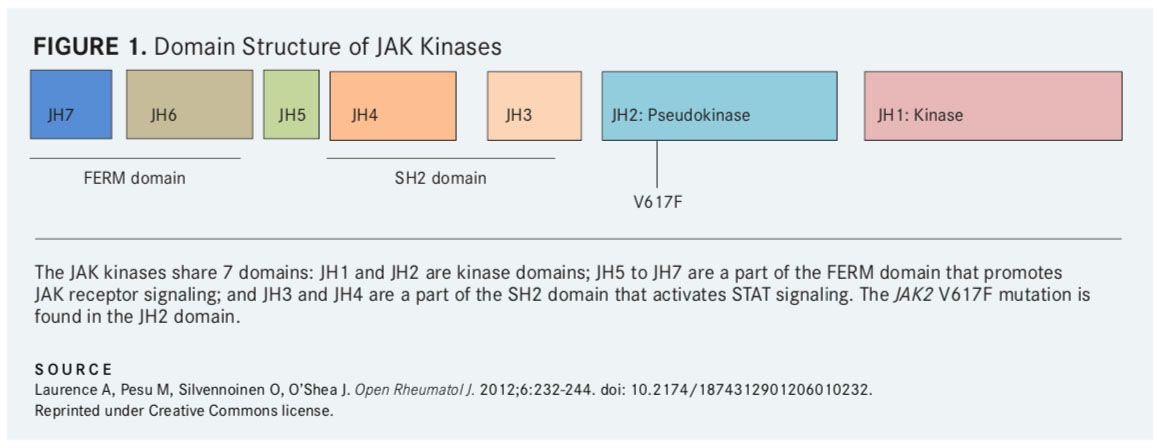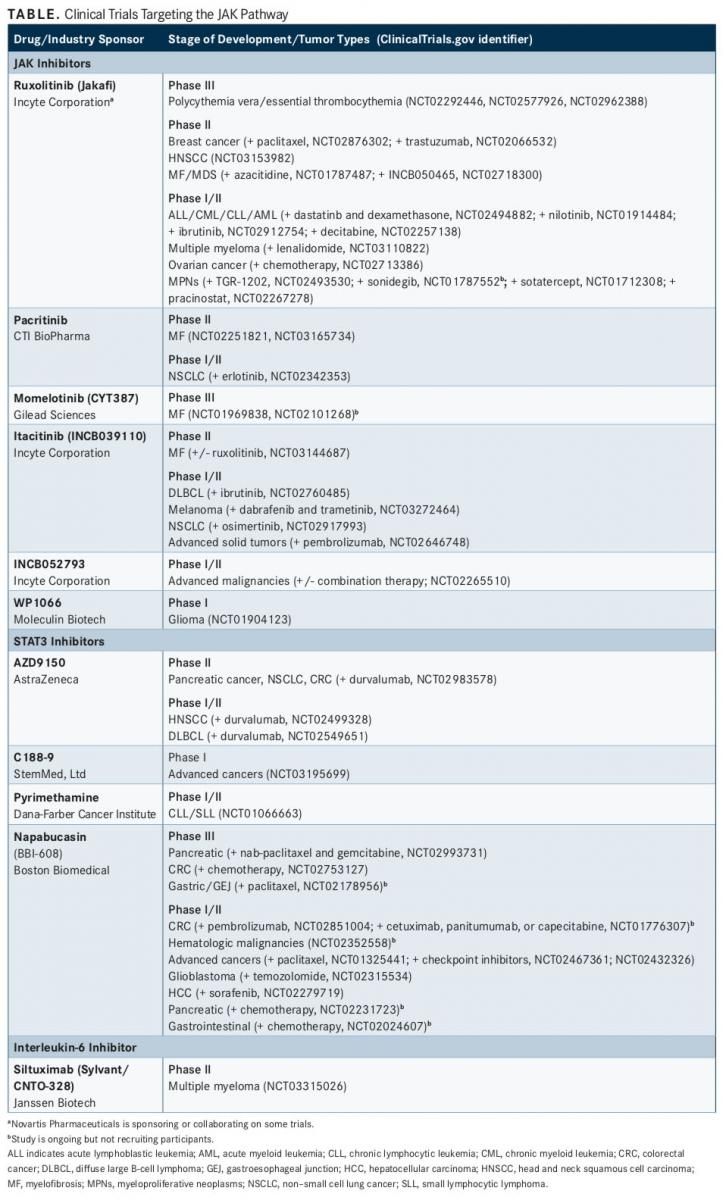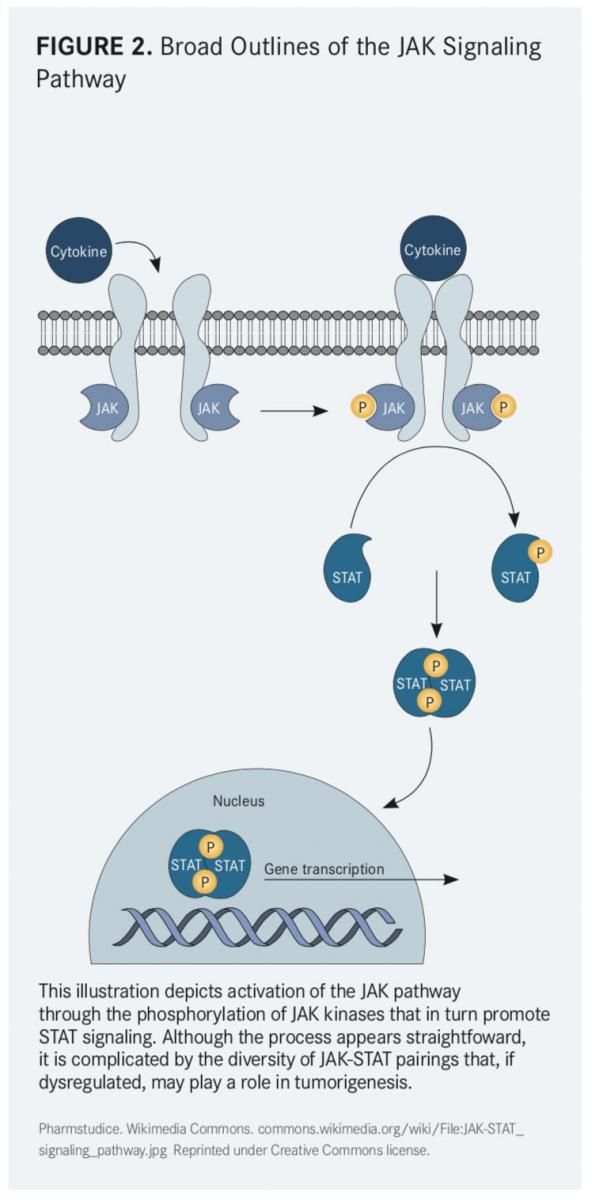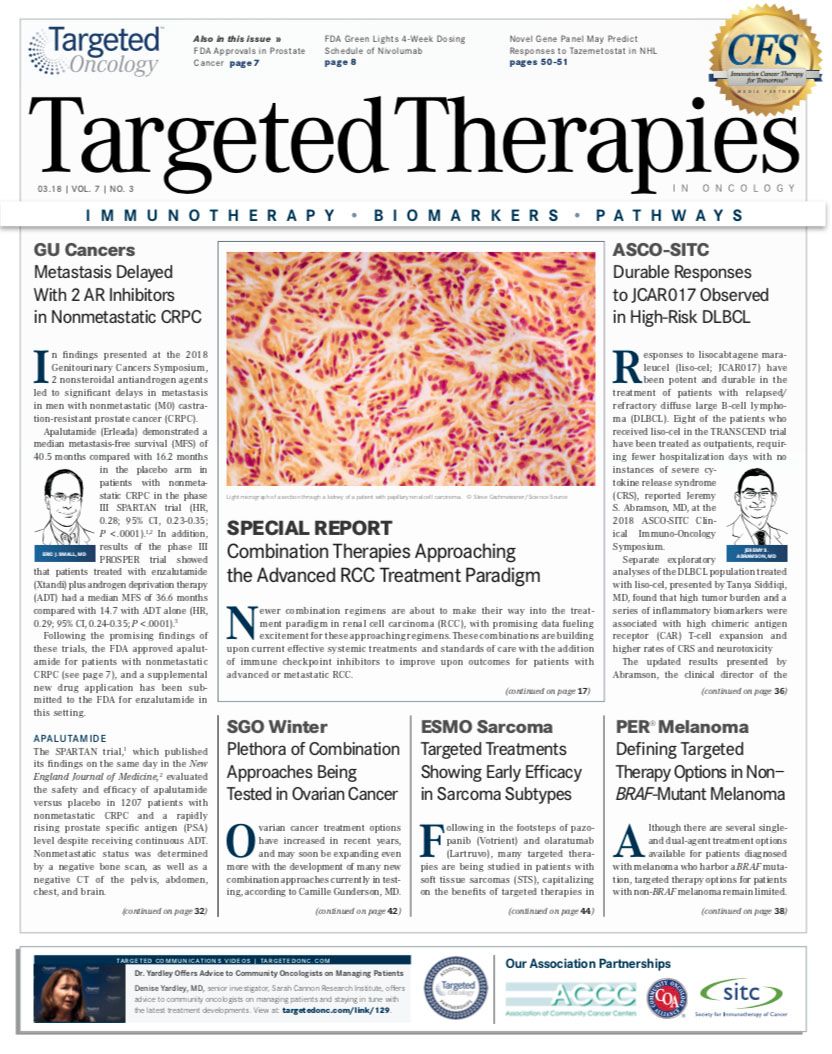Novel Approaches Tackle the JAK Pathway Beyond Ruxolitinib and Myelofibrosis
Since the identification of the role of the JAK kinase family in the late 1980s, awareness of this has grown significantly. These tyrosine<br /> kinases have been proven to transmit a variety of signals into the cells with many biological consequences, adding to the interest in the targetability of the JAK pathway. However, better understanding of the complexities of JAK signaling are being evaluated in clinical trials.
1,2in the late 1980s. Since then, these tyrosine
kinases have also been proven to transmit a variety of signals into the cells with many biological consequences, adding to the interest in the targetability of the JAK pathway.
Dysregulation of the JAK pathway plays a role in the development of numerous tumor types; it is particularly central to the pathophysiology of myelofibrosis (MF) and has long been recognized as a potentially valuable therapeutic target in that malignancy. Ruxolitinib (Jaka ), the first JAK inhibitor to gain FDA approval, has become a centerpiece in the treatment of patients with MF. JAK inhibition has not proved effective in other tumor types, and thus far, no other JAK-targeting therapies have become available.
That picture, however, may be changing. A better understanding of the complexities of JAK signaling in normal and cancerous cells and the design of rational drug combinations are poised to expand the use of JAK inhibitors in anticancer therapy for hematologic malignancies, and possibly solid tumors as well. Ruxolitinib continues to be explored in multiple malignancies, and several promising novel agents are being evaluated in clinical trials (TABLE).

A DIVERSE FAMILY WITH MULTIPLE ROLES
JAKs are now known as the Janus kinases, after the 2-faced Roman god of the same name, in recognition of their most striking feature: the presence of 2 near-identical kinase domains. There are 4 known members of the JAK family: JAK1, JAK2, JAK3, and TYK2, all sharing 7 conserved JAK homology (JH) domains within their protein structures.
At one end of the protein are JH1 and JH2, which comprise the 2 kinase domains. The rst has tyrosine kinase activity, while the second is a pseudokinase domain with no catalytic activity that is thought to negatively regulate the rst.3,4 At the other end, 3 of the JH domains collectively make up a larger FERM domain through which the JAKs are recruited to and bound by the cell-surface receptors that activate JAK signaling. A third domain, SH2, facilitates signal transducer and activator of transcription (STAT) signaling (FIGURE 1 ).5,3,6

Cytokines and their receptors are among the most significant activators of the JAK pathway. Unlike tyrosine kinase receptors, cytokine receptors have no catalytic activity and are reliant upon the JAKs to perform kinase functions for them. JAKs bind to the part of the cytokine receptor that protrudes into the cell via their FERM domain. When the cytokine receptor is activated, it pairs up with another receptor molecule and this brings 2 JAKs close enough that they are able to phosphorylate and activate one another.
Activated JAKs then phosphorylate other target proteins, including the cytokine receptor to which they are bound, forming a binding platform for proteins containing an SH2 domain, primarily STAT proteins. Once they dock to the cytokine receptor, the STATs themselves are phosphorylated by the JAK proteins and become activated (FIGURE 2).

Activated STATs subsequently disengage from the cytokine receptor, pair up with one another and move into the nucleus, where they attach to specific sequences within the DNA to either activate or, less commonly, repress the transcription of a host of target genes. In this way, the interaction between JAKs and STATs transmits a signal from outside of the cell into the nucleus to coordinate a response to the signal.
Although this at first appears to be a relatively simple signaling cascade, the activity is complicated by the fact that there are 7 STATs. The diversity of possible JAK-STAT pairings, along with the range of different ligands and receptors that can activate JAKs upstream, allows for the multiplicity of biolog- ical effects coordinated by this pathway.
In addition, the pathway is negatively regulated in several ways. One involves protein tyrosine phosphatases (PTPs), which are enzymes that can deactivate JAK by reversing its phosphorylation. The suppressors of cytokine signaling (SOCS) are a family of proteins that are activated by STATs, and turn off the JAK-STAT pathway, thereby forming a negative feedback mechanism. They do this in sev- eral ways: directly inhibiting JAK kinase activity; blocking recruitment of downstream effector pro- teins; or mediating proteasomal degradation of JAKs. Finally, protein inhibitors of activated STATs (PIAS) block the activity of STATs in the nucleus through mechanisms that remain somewhat unclear.
Further adding to the complexity is the significant cross-talk with other signaling pathways, of which we currently have a relatively poor understanding. The best characterized interaction is with the mitogen-activated protein kinase pathway, which crosses paths with JAK-STAT signaling at multiple points.3,7,8
Page Break:
A CANCER DRIVER
As a result of its myriad roles in essential cellular processes such as growth, proliferation, survival, inflammation, and immunity, JAK pathway signaling is tightly regulated in normal cells by a delicate balance between activators and inhibitors.
Disruption of this balance and aberrant activation of the JAK pathway contributes to the development and progression of numerous cancer types by promoting many of the hallmark abilities of cancer cells, such as unchecked cell growth and proliferation. Because of its important role in regulating cytokine signaling, dysregulation of the JAK pathway can also contribute to in ammation and immunosuppression in the tumor microenvironment.
The mechanisms by which the JAK pathway becomes dysregulated include mutations in the receptors that sit upstream of JAK, which drive persistent activation of JAK, or in downstream effectors, which would bypass the need for JAK activation. Alternatively, the function of molecules involved in deactivation of the pathway, such as PTPs and SOCS, may be lost.
Fusions, mutations, deletions, and insertions in the JAK1 and JAK3 genes have been noted in intestinal, skin, stomach, and endometrial cancers, among oth- ers, whereas mutations in JAK2 have been identi ed in various hematologic malignancies.9
In particular, the JAK pathway is central to the pathogenesis of myeloproliferative neoplasms (MPNs), including MF. These are cancers of the blood stem cells that cause an overproduction of white or red blood cells or platelets. Three mutually exclusive activating mutations in JAK2 are found in approxi- mately 90% of patients with MF. The most commonly observed mutation is JAK2 V617F, which drives ligand-independent activation of the JAK pathway, and is observed in 40% to 60% of patients.10,11
Activation of STATs is also commonly reported in several cancer types, including prostate cancer, nonsmall cell lung cancer (NSCLC), glioblastoma, and thyroid cancer, but is particularly prevalent in breast cancer. Upstream of JAK, increased expression of the cytokine interleukin-6 (IL-6) is observed almost universally across tumor types.3,7
RUXOLITINIB REVOLUTIONIZES MF TREATMENT
Ruxolitinib, a small-molecule inhibitor of JAK1 and JAK2, received FDA approval in 2011 for the treatment of patients with intermediate- or high-risk MF, including primary MF, or MF that follows polycythemia vera (PV) or essential thrombocythemia.
Approval in this indication was based on data from 2 randomized phase III trials, COMFORT-I and COMFORT-II, which collectively involved more than 500 patients. Ruxolitinib more effectively reduced spleen size and MF symptom burden compared with placebo (COMFORT-I) and best available therapy (BAT; COMFORT-II). These studies also demonstrated an improvement in overall survival (OS) with ruxolitinib treatment. Ruxolitinib was well tolerated; grade 3/4 adverse events (AEs) included thrombocytopenia and anemia, but these were manageable and rarely led to treatment discontinuation.
The survival bene t was con rmed in recently published 5-year follow-up data for both trials, which also showed that long-term treatment with ruxolitinib was safe, with no signi cant cumu- lative toxicity. Long-term data from COMFORT-I also suggested that ruxolitinib improved patient quality of life.12-15 Various clinical trials of ruxolitinib are ongoing, including in other MPNs, hematologic malignancies, and solid tumors.
NEW AGENTS HOLD POTENTIAL
Although there are no other FDA-approved JAK inhibitors, other drugs have generated positive data in phase III clinical trials. Momelotinib, also a JAK1/2 inhibitor, has been evaluated in the phase III SIMPLIFY trials in patients with MF.
In SIMPLIFY-1, momelotinib was compared with ruxolitinib in patients with JAK inhibitornaïve MF. The noninferiority of momelotinib was established in terms of the primary endpoint of a ≥35% reduction in spleen volume at 24 weeks. However, ruxolitinib was superior to momelotinib in the key secondary endpoint of a ≥50% reduction in total symptom score (42.2% vs 28.4%, respectively). There was also a higher rate of infections and treatment-emergent peripheral neuropathy with momelotinib.
Conversely, in the SIMPLIFY-2 trial in patients previously treated with ruxolitinib, participants who received momelotinib for 24 weeks did not experience superior outcomes for splenic response (≥35% reduction in spleen volume) compared with BAT (6.7% vs 5.8%, respectively). Nevertheless, momelotinib was signi cantly better than BAT at improving disease-related symptoms, de ned as a ≥50% reduction in total symptom score (26.2% vs 5.9%) and in the transfusion independence rate (43.3% vs 21.2%). Given these mixed results, momelotinib’s future is uncertain as researchers attempt to deter- mine the best next steps in its evaluation.16,17
Pacritinib is a small-molecule inhibitor of JAK2 and the cytokine receptor FLT3. This drug has shown significant efficacy in a phase III clinical program in MF. In the PERSIST-1 trial, 327 patients were randomized to receive pacritinib or BAT as rst-line treatment. At 24-weeks, spleen volume was reduced by ≥35% in 19.1% of patients treated with pacritinib compared with just 5% of those treated with BAT.
In the PERSIST-2 trial, pacritinib (at 2 different dosages400 mg once daily or 200 mg twice daily) was also compared with BAT in 311 patients with MF and thrombocytopenia. The primary endpoint of a ≥35% reduction in spleen volume at 24 weeks was achieved in a significantly greater number of patients treated with either dosage of pacritinib than in those who received BAT (18.1% vs 2%, respectively). In terms of this primary endpoint, the twice-daily dose was more effective than the once-daily regimen (21.6% vs 14.7%, respectively). Pacritinib was also superior in terms of total symptom score, with 25% of patients demonstrating a ≥50% reduction compared with 14% for BAT. Additionally, pacritinib reduced transfusion dependence.18,19
Despite this display of substantial ef cacy, higher death rates from intracranial hemorrhage, heart fail- ure, and cardiac arrest in the PERSIST-2 trial prompted the FDA to place a clinical hold on pacritinib in February 2016. However, less than a year later, CTI Bio-Pharma, the company developing the drug, reported that the clinical hold had been lifted after submission of nal data from the PERSIST trials.19A new clinical trial examining the safety of pacritinib in patients with primary MF who have previously received ruxolitinib has been initiated (PAC203; NCT03165734).20
The development of several other promising JAK inhibitors has been discontinued due to severe toxicities. AZD1480 caused neurological AEs, and lestaurtinib (CEP-701) resulted in frequent gastrointestinal toxicity. Fedratinib (SAR302503), a selective JAK2 inhibitor that showed significant efficacy in patients with MF in the phase III JAKARTA-1 trial, was put on a clinical hold by the FDA in 2013 after reports of potential cases of Wernicke encephalopathy. Sano subsequently discontinued its development.
However, fedratinib may be making a comeback. The rights for global development have been acquired by Impact Biomedicines. The company announced that the clinical hold was lifted based on a review of addi- tional data from 18 studies in more than 800 patients, including JAKARTA-1 and the follow-up JAKARTA-2 study, which recruited patients who were resistant to all available therapies including ruxolitinib.
In JAKARTA-2, 55% of patients treated with fedratinib experienced a ≥35% reduction in spleen size. The most common AEs were anemia, nausea, diarrhea, and vomiting, and there were no cases of encephalopathy. No clinical trials of fedratinib are ongoing, but Impact Biomedicines plans to commercialize the drug for patients with MF and PV.21-23
DEVELOPING RATIONAL COMBINATIONS
The complexity of the JAK pathway, the pleiotropic nature of its biological effects, and substantial amount of cross-talk between it and other important signaling pathways presents a signi cant challenge to the effectiveness of JAK inhibitors. The development of rational combinations of drugs could help to improve outcomes and these are starting to be studied in clinical trials.
Preclinical study results have suggested synergy between JAK inhibitors and epigenetic modi ers, such as histone deacetylase and DNA methyltransferase inhibitors (DNMTs); agents targeting the Hedgehog (Hh) pathway, which plays a critical role in hematopoietic cell development and stem cell survival; inhibitors of PI3K, a key downstream effector of JAK signaling; and immune checkpoint inhibitors targeting PD-1 and its ligands.
The results of an ongoing phase II trial of ruxoli- tinib plus azacitidine, a DNMT inhibitor, in patients with MPNs, including MF, and myelodysplastic syn- drome (MDS) were recently published. Among the 35 patients evaluable for response, 9 patients (45%) responded after the addition of azacytidine and 64% experienced >50% reduction in palpable splenomeg- aly at 24 weeks.24 Results from an ongoing phase I/ II study of ruxolitinib plus decitabine, also a DNMT inhibitor, in accelerated phase MPN or post-MPN acute myeloid leukemia demonstrated a complete response (CR) or CR with incomplete blood count recovery in 33% of patients.25 A phase I/II study of ruxolitinib in combination with the Hh inhibitor sonidegib in patients with MF is ongoing, but not actively recruiting participants. The regimen has demonstrated a ≥35% reduction in spleen size at 24 weeks in 44% of patients and was well tolerated.26
Meanwhile, the combination of JAK and PI3K inhibition has also been investigated in early-stage clinical trials. The phase Ib HARMONY trial showed promise for the combination of ruxolitinib plus buparlisib, and although studies of that combination are no longer ongoing, ruxolitinib is being evaluated in combinations with TGR-1202 and INCB050465, which are inhibitors of the delta isoform of PI3K. Pre- liminary data from the TGR-1202 study showed that the combination was well tolerated, with a clinical bene t rate of 89%.27
Despite initial promise, JAK inhibitors have suffered several high-profile failures in clinical trials in patients with solid tumors. Incyte has halted its development of ruxolitinib in solid malignancies, following lack of efficacy in patients with pancreatic and colon cancers. However, combination therapy also could help to boost ef cacy in this instance and several trials involving other JAK inhibitors are underway.
For example, there is evidence that activation of the JAK pathway could be a contributing factor to EGFR inhibitor resistance in EGFR-mutant NSCLC. A phase I study of ruxolitinib in combination with afatinib (Gilotrif) in patients with acquired resistance to EGFR inhibitors is ongoing, and preliminary data were recently presented. The combination demon- strated promising antitumor activity and was well tolerated.28 Also in this setting, itacitinib, a JAK1 inhibitor, is being evaluated in combination with osimertinib (Tagrisso).
ALTERNATIVE AGENTS
There is also some interest in targeting other com- ponents of the JAK pathway, with the cytokine IL-6 emerging as the most promising target thus far. Mono- clonal antibodies have been developed against IL-6, primarily for the treatment of in ammatory diseases such as rheumatoid arthritis. Siltuximab (Sylvant), an IL-6 inhibitor, is being evaluated in multiple myeloma.
As the principal downstream target of JAK signaling, the STAT proteins also make rational targets, but have proved to be a therapeutic challenge thus far. Several types of STAT inhibitors, predominantly aimed at STAT3 and STAT5, have been developed, including small-molecule inhibitors and, more recently, antisense oligonucleotides. The latter are short stretches of DNA or RNA that can bind to specific stretches of messenger RNA, and prevent its translation into a protein. AZD1950 is one example of this technology that has demonstrated single-agent antitumor activity in patients with treatment-refractory lymphoma or NSCLC.
References:
- Wilks AF. Two putative protein-tyrosine kinases identi ed by application of the polymerase chain reaction. Proc Natl Acad Sci U S A. 1989;86(5):1603-1607.
- Wilks AF. The JAK kinases: not just another kinase drug discovery target. Semin Cell Dev Biol. 2008;19(4):319-328. doi: 10.1016/j.semcdb.2008.07.020.
- Schieler JM, Henderson JO. Treating a dysregulated JAK/STAT pathway in cancer cells. J Student Res. 2016;5(1):11-17.
- Kisseleva T, Bhattacharya S, Braunstein J, Schindler CW. Signaling through the JAK/ STAT pathway, recent advances and future challenges. Gene. 2002;285(1):1-24.
- Groner B, von Manstein V. Jak Stat signaling and cancer: opportunities, bene ts and side e ects of targeted inhibition. Mol Cell Endocrinol. 2017;451:1-14. doi: 10.1016/j.mce.2017.05.033.
- Pencik J, Pham HT, Schmoellerl J, et al. JAK-STAT signaling in cancer: from cytokines to non-coding genome. Cytokine. 2016;87:26-36. doi: 10.1016/j. cyto.2016.06.017.
- Laurence A, Pesu M, Silvennoinen O, O’Shea J. JAK kinases in health and disease: an up- date. Open Rheumatol J. 2012;6:232-244. doi: 10.2174/1874312901206010232.
- Rawlings JS, Rosler KM, Harrison DA. The JAK/STAT signaling pathway. J Cell Sci. 2004;117(Pt 8):1281-1283. doi: 10.1242/jcs.00963.
- Janus kinase (JAK)/signal transducers and activators of transcription (STAT) signaling. My Cancer Genome website.https://www.mycancergenome.org/content/molecular-medi- cine/pathways/JAK-STAT-signaling. Updated May 24, 2016. Accessed December 1, 2017.
- Assi R, Verstovsek S, Daver N. ‘JAK-ing’ up the treatment of primary myelofibrosis: build- ing better combination strategies. Curr Opin Hematol. 2017;24(2):115-124. doi: 10.1097/ MOH.0000000000000320.
- James C, Ugo V, Le Couedic JP, et al. A unique clonal JAK2 mutation leading to con- stitutive signalling causes polycythaemia vera. Nature. 2005;434(7037):1144-1148. doi: 10.1038/nature03546.
- Harrison C, Kiladjian J-J, Al-Ali HK, et al. JAK inhibition with ruxolitinib versus best available therapy for myelofibrosis. N Engl J Med. 2012;366(9):787-798. doi: 10.1056/NE- JMoa1110556.
- Vannucchi AM, Kantarjian HM, Kiladjian JJ, et al. A pooled analysis of overall survival in COMFORT-I and COMFORT-II, 2 randomized phase III trials of ruxolitinib for the treat- ment of myelofibrosis. Haematologica. 2015;100(9):1139-1145. doi: 10.3324/haema- tol.2014.119545.
- Verstovsek S, Gotlib J, Mesa RA, et al. Long-term survival in patients treated with ruxolitinib for myelofibrosis: COMFORT-I and -II pooled analyses. J Hematol Oncol. 2017;10(1):156. doi: 10.1186/s13045-017-0527-7.
- Verstovsek S, Mesa RA, Gotlib J, et al. A double-blind, placebo-controlled trial of ruxolitinib for myelofibrosis. N Engl J Med. 2012;366(9):799-807. doi: 10.1056/NEJMoa1110557.
- Mesa RA, Kiladjian J-J, Catalano JV, et al. SIMPLIFY-1: a phase III randomized trial of momel- otinib versus ruxolitinib in janus kinase inhibitornaïve patients with myelofibrosis. J Clin Oncol. 2017;35(34):3844-3850. doi: 10.1200/JCO.2017.73.4418.
- Verstovsek S, Courby S, Griesshammer M, et al. A phase 2 study of momelotinib, a potent JAK1 and JAK2 inhibitor, in patients with polycythemia vera or essential thrombocythemia. Leuk Res . 2017;60(Supplement C):11-17. doi: 10.1016/j.leukres.2017.05.002.
- Mascarenhas J, Ho man R, Talpaz M, et al. Results of the persist-2 phase 3 study of pacri- tinib (PAC) versus best available therapy (BAT), including ruxolitinib (RUX), in patients (pts) with myelofibrosis (MF) and platelet counts <100,000/μl. Blood. 2016;128(22):LBA-5.
- Mesa RA, Vannucchi AM, Mead A, et al. Pacritinib versus best available therapy for the treatment of myelofibrosis irrespective of baseline cytopenias (PERSIST-1): an international, randomised, phase 3 trial. Lancet Haematol. 2017;4(5):e225-e236. doi: 10.1016/S2352- 3026(17)30027-3.
- CTI BioPharma announces removal of full clinical hold on pacritinib. Seattle, WA: PR News- wire; January 5, 2017; https://www.prnewswire.com/news-releases/cti-biopharma-announc- es-removal-of-full-clinical-hold-on-pacritinib-300386115.html. Accessed December 1, 2017.
- Harrison CN, Schaap N, Vannucchi AM, et al. Janus kinase-2 inhibitor fedratinib in patients with myelofibrosis previously treated with ruxolitinib (JAKARTA-2): a single-arm, open-label, non-randomised, phase 2, multicentre study. Lancet Haematol. 2017;4(7):e317-e324. doi: 10.1016/S2352-3026(17)30088-1.
- Fedratinib. Impact Biomedicines website. http://impactbiomedicines.com/fedratinib. html. Updated 2017. Accessed December 1, 2017.
- Sano discontinues clinical development of investigational JAK2 agent fedratinib (SAR302503). Paris, France: Sano ; November 18, 2013. https://en.sano .com/Imag- es/34935_20131118_JAK-2-FEDRATINIB_en.pdf. Accessed December 1, 2017.
- Assi R, Kantarjian HM, Garcia-Manero G, et al. A phase II trial of ruxolitinib in combination with azacytidine in myelodysplastic syndrome/myeloproliferative neoplasms. Am J Hematol. 2018;93(2):277-285. doi: 10.1002/ajh.24972.
- Rampal RK, Mascarenhas JO, Kosiorek HE, et al. Safety and e cacy of combined rux- olitinib and decitabine in patients with blast-phase MPN and post-MPN AML: results of a phase I study (Myeloproliferative Disorders Research Consortium 109 trial). Blood. 2016;128(22):1124.
- Gupta V, Harrison CN, Hasselbalch H, et al. Phase 1b/2 study of the e cacy and safety of sonidegib (LDE225) in combination with ruxolitinib (INC424) in patients with myelo bro- sis. Blood. 2015;126(23):825.
- Moyo TK, Sochacki A, Ayers GD, et al. Preliminary results from a phase I dose es- calation trial of ruxolitinib and the PI3Kδ inhibitor TGR-1202 in myelofibrosis. Blood. 2016;128(22):1125.
- Park JS, Kim HR, Hong MH, Cho BC. A phase Ib study of the combination of afatinib and ruxolitinib in EGFR mutant non-small cell lung cancer (NSCLC) progressed on EGFR-TKI. J Thorac Oncol. 2017;12(1):S1069-S1070. doi: 10.1016/j.jtho.2016.11.1496.

Survivorship Care Promotes Evidence-Based Approaches for Quality of Life and Beyond
March 21st 2025Frank J. Penedo, PhD, explains the challenges of survivorship care for patients with cancer and how he implements programs to support patients’ emotional, physical, and practical needs.
Read More